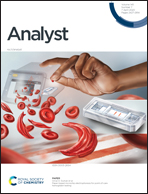Paper-based electrodes modified with cobalt phthalocyanine colloid for the determination of hydrogen peroxide and glucose
Abstract
Cobalt(II) phthalocyanine (CoPc) was suspended in aqueous medium and the colloidal system was used as catalyst for the electrochemical determination of hydrogen peroxide on paper-based electrodes modified with carbon nanomaterials. H2O2 was oxidised at 0.275 V vs. Ag pseudoreference electrode. This system was adapted to develop a glucose sensor with glucose oxidase immobilized on the cellulose electrode. CoPc suspended nanoparticles acted as nanoenzyme mimicking peroxidase activity and were combined with different carbon nanomaterials to form hybrids with optimised catalytic performance. GO-CoPc paper-based electrodes yielded the best results with a linear range of ∼12 μM to 49 mM for H2O2 and 0.1 mM to 1 mM for glucose. Glucose was determined in physiological serum and juice samples with recoveries of 93.3 and 94.2% respectively. CoPc could replace HRP for the catalytic sensing of H2O2, without the need to be dissolved. This material can be used in situ in a simple protocol with other nanomaterials for electrode modification. The sensor described has the advantage of easy preparation, using the catalyst in colloidal form, long term stability, and versatility to be adapted to other low cost and disposable enzymatic systems.



 Please wait while we load your content...
Please wait while we load your content...